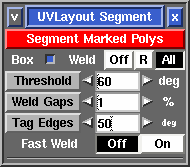User Guide: Segment
From UVLayout Docs
(Difference between revisions)
| Revision as of 06:39, 25 May 2009 (edit) Headus (Talk | contribs) ← Previous diff |
Revision as of 06:46, 25 May 2009 (edit) (undo) Headus (Talk | contribs) Next diff → |
||
| Line 5: | Line 5: | ||
| ; Box : Dropped shells are boxed. This makes it easier to move them around as a group. | ; Box : Dropped shells are boxed. This makes it easier to move them around as a group. | ||
| - | ; Weld : When set to '''Off'', no re-welding of shells is performed. When set to '''R''', shells that form parts of revolved shapes (e.g. pipes, wheels, bolts, balls) are welded back together. When set to '''All''', all remaining shells are welded so long as no overlaps are created. | + | ; Weld : When set to '''Off''', no re-welding of shells is performed. When set to '''R''', shells that form parts of revolved shapes (e.g. pipes, wheels, bolts, balls) are welded back together. When set to '''All''', all remaining shells are welded so long as no overlaps are created. |
| - | + | ||
| - | ; Opt : Dropped shells are briefly optimized. Further flattening may be required, via the '''Optimize''' tool, for more complex shapes. | + | |
| ; Threshold : This angle determines at which point adjoining polys are split apart. Increasing this angle will result in less fragmentation (i.e. fewer shells), but there will be more distortion in the resulting UVs and extra cuts or darts may need to be added. Reducing this angle will increase the fragmentation, and so more time will need to be spent welding shells back together. | ; Threshold : This angle determines at which point adjoining polys are split apart. Increasing this angle will result in less fragmentation (i.e. fewer shells), but there will be more distortion in the resulting UVs and extra cuts or darts may need to be added. Reducing this angle will increase the fragmentation, and so more time will need to be spent welding shells back together. | ||
Revision as of 06:46, 25 May 2009
|
The Segment tool is used to speed up the flattening of "hard" surface geometry, that is, non-organic shapes like buildings, furniture and other props. [Professional Version Only]
|
